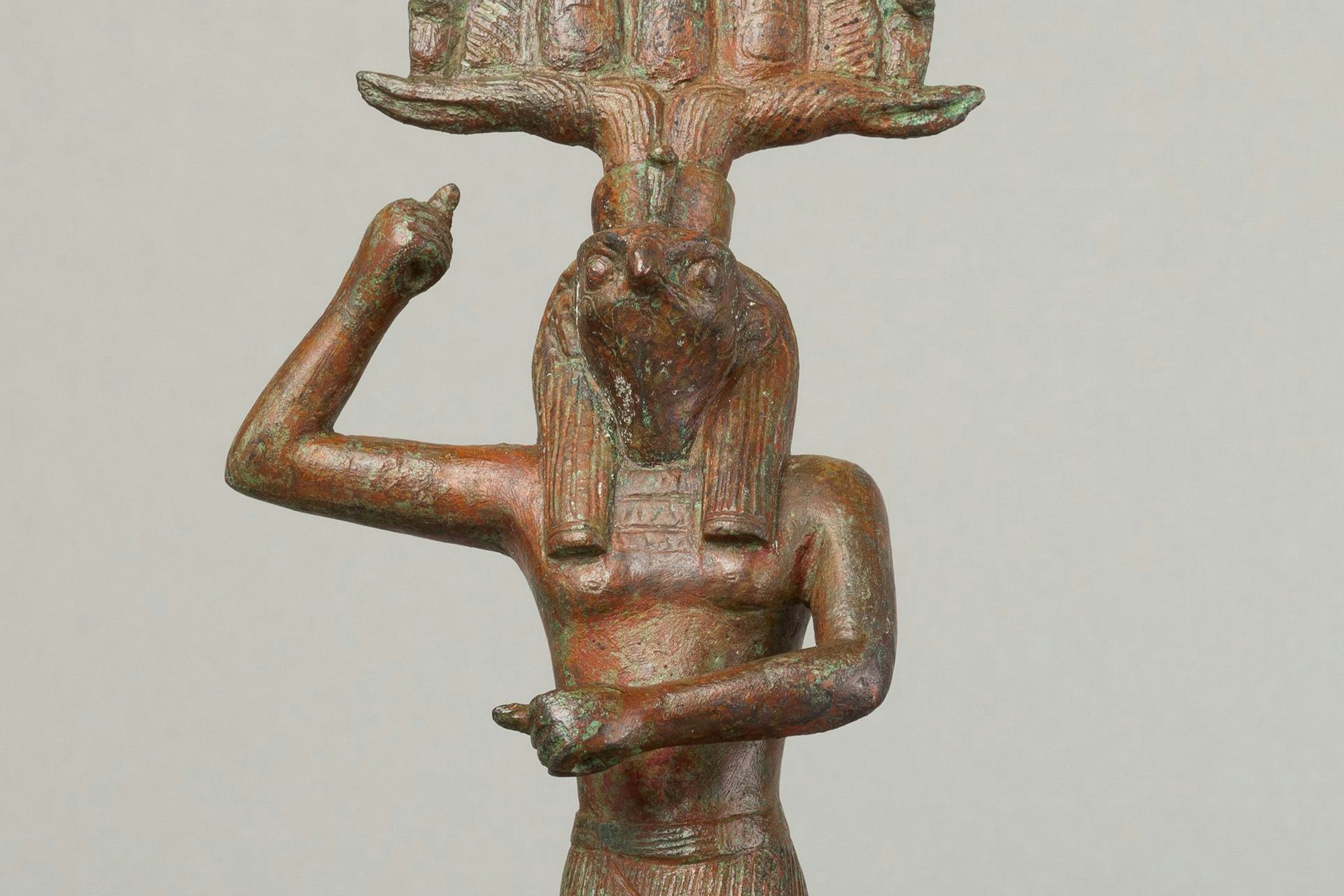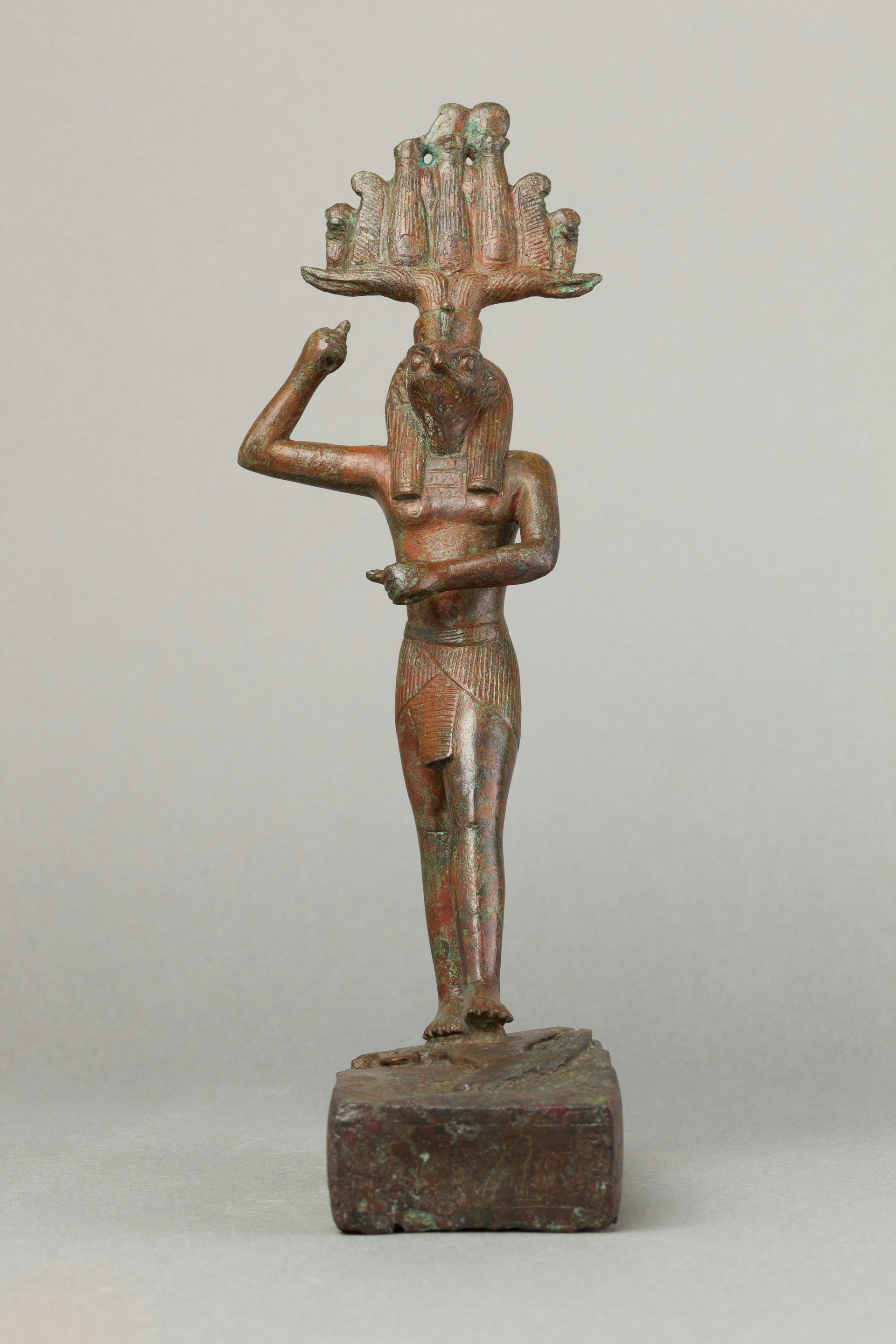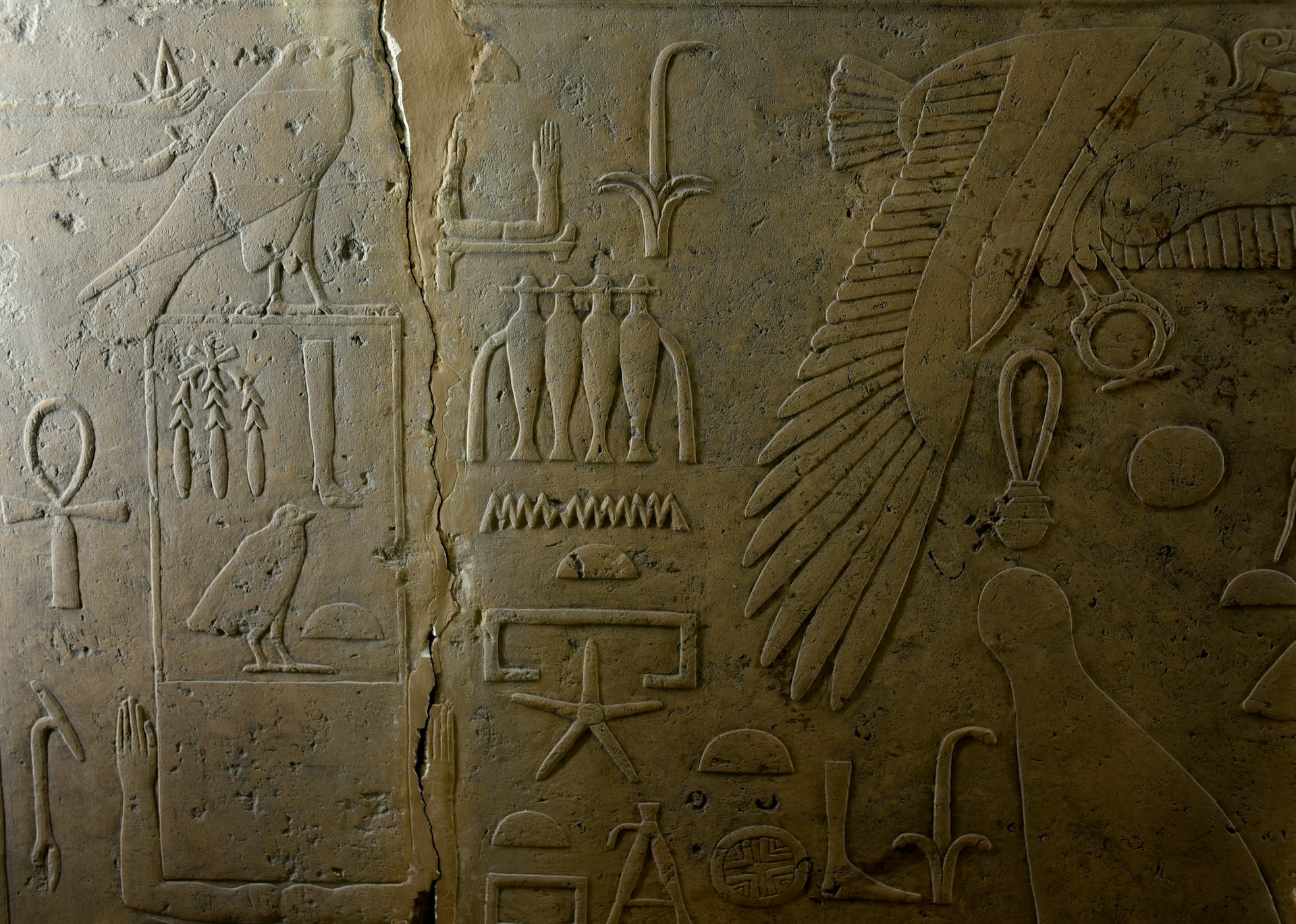Horus

Overview
An incredibly important figure in the Egyptian mythos, Horus was a complex and occasionally contradictory god. The ancient Egyptians believed him to have a number of manifestations, with each representing a different facet of his being. A sun and sky god in equal measure, he was typically represented by a falcon and embodied the principles of Egyptian kingship.

Falcon-headed Horus once held a spear above an antelope at the base of this statuette (664–525 BCE). The antelope is thought to represent Set, whom Horus defeated to become ruler of Egypt.
The Metropolitan Museum of Art Public DomainA passing familiarity with the major figures from the Egyptian pantheon will give the impression that Horus was the child of Isis and Osiris, destined to retake his father’s throne. This statement was true, but Horus was also much more than that. The Egyptians worshipped Horus for over three thousand years, and over time he was merged with similar deities and their accompanying mythologies.
As a result of his milllennia of worship, Horus’s mythos has become somewhat confusing. Horus was not subject to temporal consistency, and existed simulatenously as both child and adult. In one myth that exemplified this paradox, Horus appeared as Hathor’s son, husband, and father—all at the same time.
In order to better understand Horus, several of his more prominent manifestations will be examined in isolation. It is important to note that the ancient Egyptians recognized all of these incarnations to be aspects of the same god.

A serekh (rectangular box, left) from the reign of Pharaoh Amenemhat I of the 12th Dynasty. The falcon sitting atop the box represents Horus.
Osama Shukir Muhammed AminCC BY-SA 4.0Horus the Falcon
The deity’s oldest manifestation, Horus the Falcon was also known as Horus the Sky God, Horus the Lord of the Sky, Horus of Two Horizons, Horakhty, Ra-Horakhty, and Hor-em-akhet (Horus in the Horizon, or Harmachis to the Greeks).
Horus the Elder
Found only in Greek sources, Horus the Elder was the son of Nut and Geb. He was also known as Horus the Great, Harwer, and Haroeris.
Horus the Younger
Horus the Younger is Likely the most recognizable iteration of the deity, Horus the Younger, was the son of Isis and Osiris, and figured prominently in some of the best-known Egyptian myths.
Etymology
Horus’s name was derived from the Egyptian word her, meaning “the one on high” or “the distant one,” a reference to a soaring falcon or the sun itself.[1]
Horus the Younger
The ancient Egyptians called this iteration Horus the Younger, Harsiese (Horus, son of Isis), and Har-Hery-Wadj (Horus Upon His Papyrus Plants, referencing his birth in the papyrus swamps of Chemmis).[2]
He was also referred to as Hor Pa-Khered (literally: Horus the Child) which the Greeks transliterated as Harpokrates.[3]
Attributes
Despite having many different manifestations, the aspects of Horus share many features with one another.
Horus the Falcon
The deity’s oldest known manifestation, Horus the Falcon has been found on artifacts dating back to the 1st Dynasty (3050 BCE). Once such object, an ivory comb, depicted Horus as a falcon riding in a boat with outstretched wings. His speckled breast feathers represented the stars, his outstretched wings represented the sky, and his eyes represented the sun and the moon.[7]
Originally a god of Southern Egypt (Nekhen), Horus the Falcon’s influence grew and spread. Over time he was merged with other falcon, sky, and solar gods. One of these mergers was with Ra—resulting in Ra-Horakhty. This composite god was depicted as a falcon crowned by a solar disk.[8]
Horus of Behdebt
Horus of Behdebt was a fairly unique interpretation of Horus. Best known from his depictions at the Temple of Edfu in Upper (Southern) Egypt, he may have been worshipped in Tell el-Balamun in Lower Egypt.
Similar to other iterations of the deity, Horus of Behdebt was most often depicted as a falcon; he was also portrayed as a lion or winged sun disk.[9]
Horus the Elder
Horus the Elder was Lord of the Sky, with wings that spanned the heavens. Like Horus the Falcon, his eyes were the sun and the moon. While Horus the Elder was often portrayed as a falcon-headed man, he rarely (if ever) appeared as a fully-fledged falcon.[10]
Horus the Younger
Like Horus the Elder, Horus the Younger was shown as a falcon-headed man, often crowned by a solar disc.
Horus the Child
Horus the Child was closely linked to Horus the Younger, but was usually depicted in a different manner. Horus the Child was portrayed as a young, typically nude, boy with a shaved head and a plaited sidelock of hair. To emphasize his youth, he was often shown with his finger in his mouth.[11]
The distinction between Horus the Child and Horus the Younger came from the ancient Greeks and Romans, who worshipped Horus the Child as a separate entity.[12]
The Greco-Roman worship of Horus the Child incorporated another Horus as well—Horus the Savior. Also known as Shed, Horus the Savior appeared in stelae (stone slabs commemorating an event, royal decree, or religious texts) dressed as a young prince, usually wielding a curved sword or bow; he was sometimes depicted trampling crocodiles or strangling lions and snakes. The Greeks identified this manifestation with Hercules, who famously strangled two snakes in his bassinet.[13]
It was common for Horus the Savior and Horus the Child to be found on amulets and bronze plaques called cippi (s. cippus), themselves successors to Egyptian stelae.[14]
Plutarch identified Harpokrates as yet another iteration of child Horus. In his interpretation, Harpokrates was the lame and premature child of Isis and Osiris. Plutarch may have mistaken the Egyptian dwarf god Bes for Horus, however, as Bes not only matched this physical description, but frequently appeared on stelae as well.[15]
Horus and the Planets
Though the Egyptians practiced a heliocentric religion, the night sky was still extremely important to them. As some of the brightest objects in the sky, planets were given special status and associated with various gods. The Egyptians knew of five planets—Mercury, Venus, Mars, Saturn, and Jupiter—and associated Horus with three of them.[16]
Mars: Horus of the Horizon, or Horus the Red
Jupiter: Horus Who Limits the Two Lands
Saturn: Horus, Bull of the Heavens
Family
Horus the Elder
Horus the Elder has an unclear parentage. Greek sources contend that he was the second child of Nut and Geb, while Egyptian sources positioned him as the son of Hathor and Ra.[17]
According to the Coffin Texts, Horus and Isis had four children: Duamulef, Qebehsenuef, Imsety, and Hapy. These children protected the organs of the dead, which were preserved in canopic jars. These gods were collectively known as the Sons of Horus.
The Sons of Horus were somewhat unique, in that they were not regarded exclusively as their own beings but were considered to be bau of Horus.[18]
Ba (pl. bau) was a form through which a god could be experienced on earth; a physical manifestation of the divine[19]
Horus of Behdebt
Horus of Behdebt was the husband of Hathor and father of Horus, Uniter-of-the-Two-Lands (also known as Horus Sematawy or Harsomtus) and Ihy.[20]
Horus the Younger
Horus the Younger came to prominence after the rise of the Osirian mythology. The son of Isis and Osiris, he first appeared in the Pyramid Texts during the 6th Dynasty (c. 2345-2181 BCE).[21]
Other Associations
The Edfu temple hosted an annual festival celebrating Horus’s “beautiful union” with Hathor, who was featured not only as Horus’s mother, but as his consort and daughter as well.[22]
The scorpion goddess Ta-Bitjet was sometimes referred to as the wife of Horus, though which iteration she was married to remains unclear.[23]
Family Tree
Mythology
Horus the Falcon
According to a creation myth from the walls of the Edfu Temple, there was a time when the world was not yet formed and all that existed was a vast swamp. Two mysterious beings worked together to subdue this primeval swamp by cutting down its reeds. When they finally cleared a patch, one of them stuck a reed in the ground and a falcon alighted upon it. The beings proceeded to build a hut around the falcon, and this building became both the center of the world and its first temple.[27]
Horus of Behdebt
Myth of the Winged Disk:
I don’t have a good source for this. I just know that Horus the Distant One blinded and destroyed his enemies. Pinch 145.
Horus the Elder
Horus the Elder was most readily seen in Greek sources, where he was called Apollo. According to the Greek historian Diodoros of Sicily, Horus the Elder accompanied Osiris on his civilizing expedition.[28]
To read more about Osiris’s exploits as king, see Osiris: The Earthly Reign of Osiris.
In some versions of the Death of Osiris myth, Horus the Elder assisted Isis and Nephthys in the search for and subsequent reconstruction of Osiris’s body.[29]
The Eye of Horus
A common theme in Horus’s mythology was the damage or theft of his eyes. Set was generally the culprit behind such schemes, and Horus would often require the aid of another deity in restoring his vision.
Eyes were regarded as deities unto themselves, perhaps because irt, the Egyptian word for eye, closely resembled the Egyptian word for “doing” or “acting.” As irt was feminine, the eyes of masculine gods were treated as goddesses.
When intact, the eye of Horus, or wedjat, represented maat—divine order. Any attack on the eyes, then, was an attack on order itself.
Two of Horus’s manifestations were defined by their eyes (or lack thereof). Khenty-irty was a form of Horus depicted as an ichneumon, a type of mongoose praised for its vision. On the opposite end of the spectrum was Khenty-en-irty, an aspect of Horus represented as a species of eyeless shrew. This blind iteration of Horus was a vengeful god who punished the wicked for their sins.[30]
Horus’s eyes were regarded as the sun and the moon, though which eye was which remains unclear. While many stories mentioned that Horus’s eye was damaged, few explicitly described what happened to it. Accounts tend to agree, however, that Horus’s injured eye was the moon, explaining its vastly reduced brightness in comparison to the sun. The waxing moon was thought to be Horus’s eye gradually recovering from its injuries.[31]
Several tales of the destruction of Horus’s eye(s) come to us from the mythos of Horus the Younger. In one story, Horus beheaded his mother in an act of unthinking rage. Set punished him by tearing out both of his eyes and burying them in the mountains, where they grew into lotus flowers. Hathor later restored Horus’s sight using gazelle’s milk.[32]
In one myth, Thoth was said to put Horus’s eye back together, suggesting that—like Osiris’s body—it had been torn apart. The tale may have justified the use of the wedjat hieroglyph in representing the fractions of a standard grain measurement. Each fraction was represented by a different portion of the eye.[33]
Horus the Younger
Horus the Younger’s origin story ran parallel to an older tale in which a sun child was born from a lotus blossom. A primeval goddess protected the child from monstrous, chaotic creatures that sought to destroy him. Because this sun child was destined to create the world during the first sunrise, his survival was of the utmost importance.[34]
When Horus was conceived, Isis knew at once that he was destined to become king and bring order to Egypt. Horus’s uncle, the illegitimate king Set, also recognized what fate had in store for the boy. He and his followers worked tirelessly to destroy Horus, but thanks to the interventions of Isis, Nephthys, Hathor, and others, their efforts were all in vain.[35]
For a more detailed account of Horus’s birth and childhood, see Isis: The Conception of Horus and Isis: The Birth of Horus.
The Heir to Osiris
Horus the Younger had a key role in one of Egypt’s best-known myths: The Death of Osiris. In this tragic tale, the evil Set killed his brother Osiris and usurped his throne.
After a lengthy search, Osiris’s wife Isis managed to recovered his body which, depending on the myth, had either been chopped into 26 pieces by Set or suffered the effects of natural decay.[36] All myths agreed, however, that Osiris’s penis could not be salvaged, forcing Isis to reconstruct it out of wax.
Wax phallus notwithstanding, Isis’s efforts proved sufficient to allow Osiris to impregnate her with Horus. Set immediately became aware of young Horus’s conception and tried to destroy him before he came of age.[37]
Despite Set’s best efforts, Horus reached the age of majority and challenged Set for his throne. After a series of literal and metaphorical trials, Horus defeated his uncle and took his rightful place as ruler of Egypt.
To read more about Horus’s legal and martial battles with Set, see Isis: Isis and the Ascendancy of Horus.
Conflict Between Horus and Set
The primeval battle between Horus and Set ultimately ended in reconciliation. Even after his lengthy and often ruthless dispute with Horus, Set was granted a position at the prow of Ra’s solar barque. The forgiveness of Set was no accident. The ancient Egyptians believed in duality, and while Set’s actions were generally regarded as chaotic or evil, he was also considered a necessary part of the universal order.
Set the usurper still had to lose to Horus, however, as rightful kingship superceded duality in the Egyptian belief system.[38]
Pop Culture
While Egyptian culture is often viewed as a monolith, the reality is that it spanned three millennia and became incredibly diverse over time. Elements of Egyptian mythology were also incorporated into Greek and Roman worship.
Even the Egyptians sometimes appear to have developed a popular memory for their massive icons. The Great Sphinx of Giza was erected during the reign of King Khafre (c. 2500 BCE) and its true purpose remains something of a mystery. However, about one thousand years after its construction, the Egyptians believed it to be a depiction of Hor-em-akhet, or Horus of the Horizon. This massive stone figure was so old that even the culture that generated it lost sight of its original meaning.[39]
In modern pop culture, Horus can be found in television, cinema, and video games.
Stargate SG-1 featured the Egyptian gods prominently amongst the race of aliens known as Goa’uld. Horus—called Heru-ur in the show—was described as being the son of Ra and Hathor.[40] Such parentage suggests this iteration was based on Horus the Elder, rather than the better known Horus the Younger.
Nikolaj Coster-Waldau portrayed Horus in the 2016 film Gods of Egypt. The film followed Horus as he attempted to oust the usurper Set from his throne.[41]
The tabletop game series Warhammer 40K featured a story arc called the Horus Heresy. Both the plot and antagonist Horus Lupercal were named after the god Horus, though neither had further ties to Egyptian mythology.[42]
In the massive online battle arena (MOBA) Smite, Horus appeared as a playable character. The game incorporated several elements of Horus’s mythology: he was portrayed as a falcon-headed man, and described in-game as the “Rightful Heir,” a nod towards Horus the Younger’s rivalry with Set. The game incorporated Egyptian myths into its game mechanics as well. Horus’s rivalry with Set was included in the form of Horus’s passive ability "Resolute," which offered greater protection against Set’s attacks.[43]